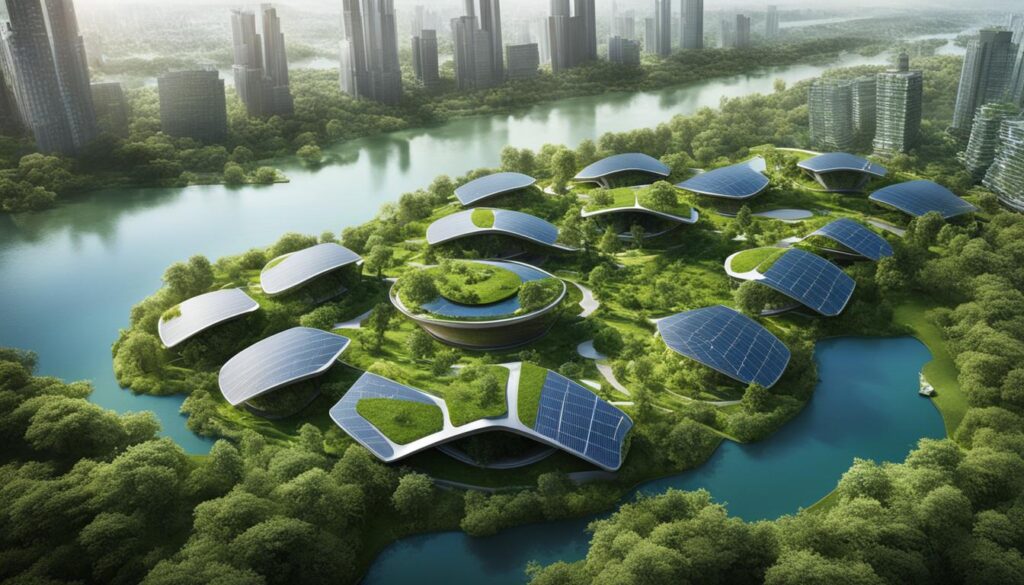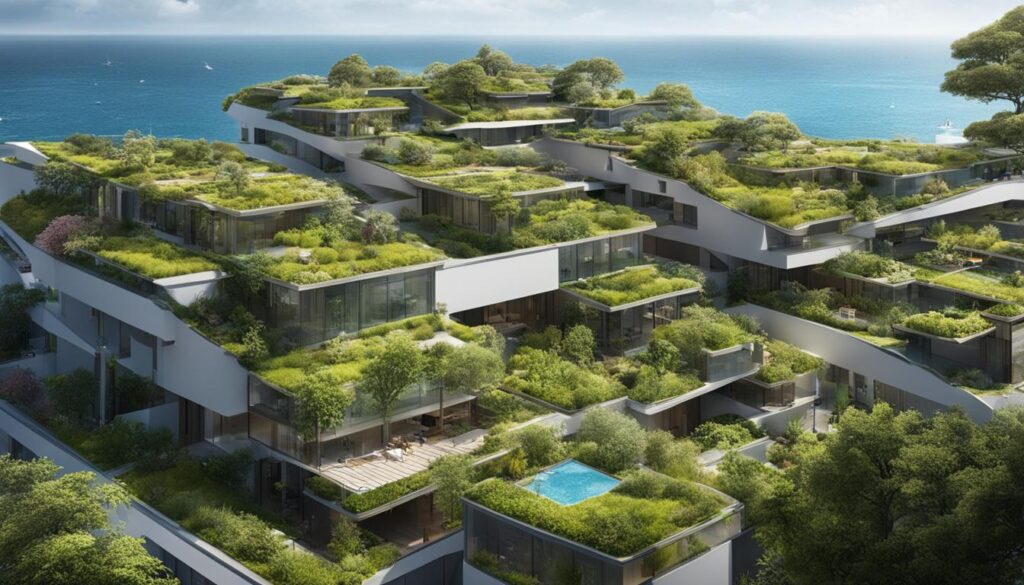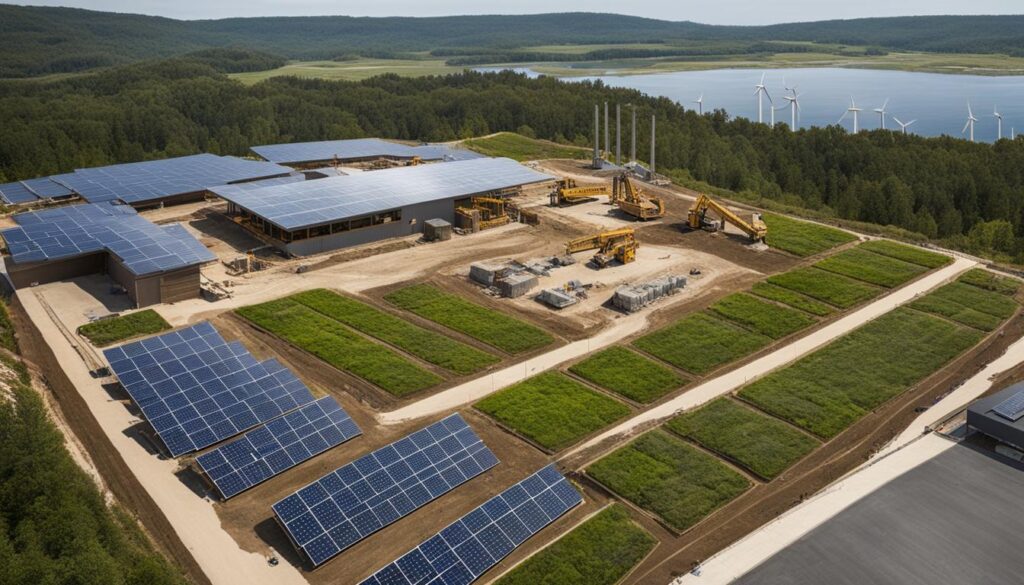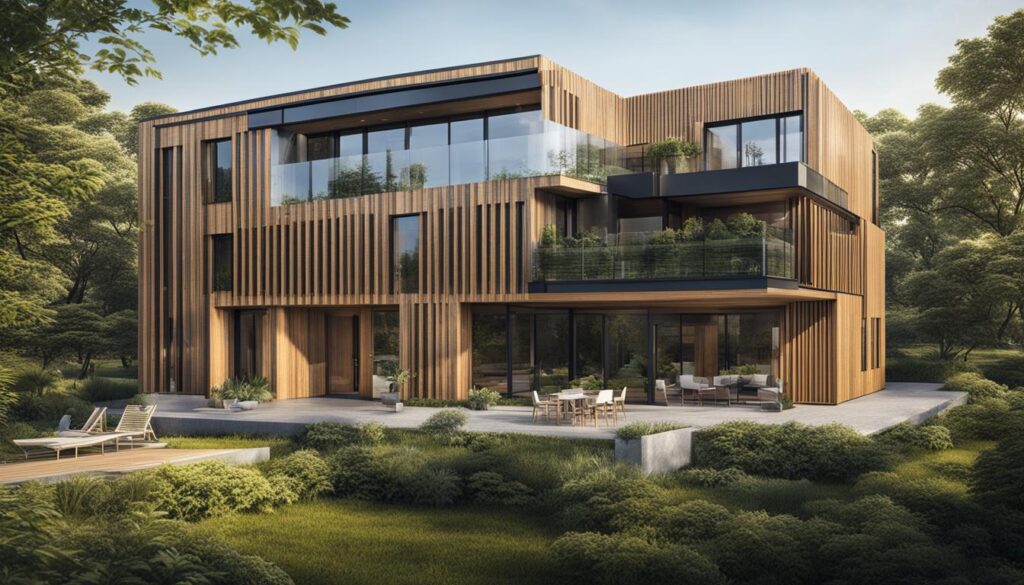I have always been passionate about environmentally sustainable design (ESD) and its potential to create a more sustainable future. So, you can imagine my excitement when I discovered the incredible initiatives and programs being undertaken by the Bass Coast Shire Council in promoting ESD in our region. From sustainable architecture to renewable energy, they are truly leading the way in creating a greener and more environmentally conscious community.
But what exactly is ESD and why is it so important? Let’s dive in and explore the world of environmentally sustainable design and how it is making a positive impact on the Bass Coast Shire.
Key Takeaways:
- ESD promotes eco-friendly design principles and energy-efficient technologies.
- It aims to reduce energy consumption, water usage, waste generation, and greenhouse gas emissions.
- ESD creates healthier and more comfortable living and working environments.
- The Bass Coast Shire Council offers grants, incentives, and education programs to promote ESD.
- Sustainable construction practices and green buildings are encouraged in the region.
What is Environmentally Sustainable Design (ESD)?
Environmentally Sustainable Design (ESD) is a holistic approach to designing and constructing buildings that minimize their negative impact on the environment and promote sustainability. It involves integrating eco-friendly design principles, energy-efficient technologies, and renewable energy sources to create buildings that are environmentally responsible and resource-efficient.
ESD aims to reduce energy consumption, water usage, waste generation, and greenhouse gas emissions, while creating healthier and more comfortable living and working environments. By incorporating sustainable design strategies, such as passive heating and cooling, natural daylighting, and efficient insulation, ESD helps to improve energy efficiency and reduce reliance on non-renewable resources.
Furthermore, ESD takes into consideration the entire lifecycle of a building, from its design and construction to its operation and eventual demolition. It emphasizes the use of recycled and sustainable materials, efficient waste management systems, and the minimization of embodied energy in construction. By adopting ESD practices, buildings can become more resilient, adaptable, and environmentally friendly.
The Principles of ESD:
- Energy efficiency and conservation
- Use of renewable energy sources
- Water efficiency and conservation
- Waste reduction and recycling
- Use of sustainable and recycled materials
- Healthy indoor environment
- Adaptive and resilient design
ESD aims to create a built environment that is not only environmentally sustainable but also economically viable and socially responsible. It is about finding a balance between the needs of the present generation and the ability of future generations to meet their own needs. By adopting ESD principles, we can create a more sustainable and livable future for all.
Table: Benefits of Environmentally Sustainable Design
| Benefits | Description |
|---|---|
| Reduced environmental impact | ESD practices help to minimize energy consumption, water usage, waste generation, and greenhouse gas emissions, resulting in a smaller carbon footprint. |
| Improved resource efficiency | By using sustainable materials, implementing efficient water management systems, and reducing waste, ESD promotes the efficient use of resources and reduces the strain on natural ecosystems. |
| Healthier indoor environments | ESD focuses on creating buildings that provide healthy and comfortable indoor environments, with good ventilation, natural lighting, and low levels of pollutants. |
| Enhanced resilience | ESD practices make buildings more resilient to climate change and other environmental risks, ensuring they can adapt and withstand changing conditions. |

The Benefits of ESD in Bass Coast Shire
Implementing environmentally sustainable design (ESD) practices in the Bass Coast Shire brings forth numerous benefits. It helps to reduce the carbon footprint of the region by decreasing energy usage and greenhouse gas emissions. ESD also promotes resource efficiency, reduces water consumption, and minimizes waste generation. Additionally, sustainable buildings and developments create healthier indoor environments, enhance the quality of life for residents, and contribute to the overall resilience and sustainability of the community.
By incorporating ESD principles into the design and construction of buildings in Bass Coast Shire, we can significantly reduce the environmental impact of our built environment. Through energy-efficient design and the use of renewable energy sources, we can lower our energy consumption and decrease greenhouse gas emissions, thus mitigating climate change. Sustainable buildings also enhance the health and well-being of occupants by providing better indoor air quality, natural light, and thermal comfort. This creates a more productive and enjoyable living and working environment for everyone in the community.
Moreover, ESD practices in Bass Coast Shire contribute to the conservation of natural resources. By reducing water consumption, implementing efficient waste management systems, and utilizing recycled and sustainable building materials, we minimize resource extraction and waste generation. This not only protects the environment but also saves costs in the long run. Additionally, incorporating green spaces, urban forestry, and biodiversity elements in sustainable developments enhances the ecological value of the region and creates a more resilient and sustainable community for future generations.

Overall, the adoption of environmentally sustainable design practices in Bass Coast Shire benefits the environment, the community, and the economy. By prioritizing sustainable development and energy-efficient design, we can create a more ecologically responsible and resilient region. The numerous advantages, including reduced energy consumption, improved indoor air quality, and resource efficiency, make ESD a vital aspect of building a sustainable future for Bass Coast Shire.
ESD Initiatives and Programs by Bass Coast Shire Council
When it comes to promoting environmentally sustainable design (ESD), the Bass Coast Shire Council is at the forefront. They have implemented a range of initiatives and programs that encourage sustainable practices in the region. From grants and incentives for sustainable building projects to education and awareness programs, the council is committed to making a difference.
One of the key initiatives introduced by the council is the Sustainable Building Program. This program provides financial incentives to residents and businesses for incorporating ESD principles into their building projects. It not only helps to reduce the environmental impact but also promotes the use of renewable energy and resource-efficient materials.
In addition, the council collaborates with industry professionals to develop sustainable design guidelines and standards. By working hand in hand with architects, builders, and developers, they ensure that sustainable practices are integrated into every stage of the design and construction process.
An example of their commitment to ESD is the installation of solar energy systems and energy-efficient lighting in public spaces. This not only reduces the carbon footprint but also serves as a visual reminder of the council’s dedication to sustainable practices.

Sustainable Building Program Incentives
| Incentives | Description |
|---|---|
| Grants | Financial assistance for incorporating ESD principles into residential and commercial building projects. |
| Tax credits | Tax incentives for implementing energy-efficient technologies and renewable energy systems. |
| Education and workshops | Free training programs and workshops to educate residents and builders on sustainable construction practices. |
| Consultation services | Expert advice and guidance on ESD practices for architects, builders, and developers. |
“Our goal is to create a sustainable and resilient community by promoting environmentally responsible practices. By providing incentives, education, and support, we aim to inspire individuals and businesses to embrace ESD principles in their projects and everyday lives”.
Through these initiatives and programs, the Bass Coast Shire Council is paving the way for a greener and more sustainable future in the region. Their commitment to ESD is not only benefiting the environment but also creating a healthier and more resilient community.
Sustainable Construction Practices in Bass Coast Shire
When it comes to environmentally sustainable design (ESD), the Bass Coast Shire Council is committed to promoting sustainable construction practices in the region. By embracing eco-friendly design principles and implementing energy-efficient strategies, the council is creating a more sustainable and resilient community.
In line with this commitment, the council encourages the use of recycled and sustainable building materials in construction projects throughout the Bass Coast Shire. By opting for materials that have a reduced environmental impact, such as recycled timber or low-carbon concrete, builders can minimize their carbon footprint and contribute to a greener future.
The council also emphasizes the importance of incorporating energy-efficient design strategies. This includes using passive design principles to maximize natural lighting and ventilation, reducing the need for artificial heating and cooling. By incorporating these strategies, buildings in the Bass Coast Shire can significantly reduce their energy consumption and environmental impact.
Furthermore, the council supports the construction of green buildings that meet specific sustainability criteria. These criteria encompass various aspects, including energy and water efficiency, indoor air quality, and waste management. By promoting and endorsing green buildings, the council encourages the construction industry to prioritize sustainability and contribute to a more environmentally responsible future.

Table: Examples of Sustainable Construction Practices
| Sustainable Construction Practice | Description |
|---|---|
| Use of Renewable Energy | Installing solar panels or wind turbines to generate clean, sustainable energy for buildings. |
| Rainwater Harvesting | Collecting and storing rainwater for various purposes, such as irrigation or toilet flushing. |
| Green Roof | Implementing a vegetated roof system that contributes to thermal insulation and stormwater management. |
| High-performance Insulation | Using insulation materials with high thermal resistance to reduce heat transfer and energy loss. |
| Passive Solar Design | Orienting buildings to maximize solar heat gain and natural lighting, reducing the need for artificial heating and lighting. |
By adopting these sustainable construction practices, the Bass Coast Shire is not only minimizing its environmental impact but also setting an example for other regions to follow. Through its focus on sustainable construction, the council is creating a more environmentally friendly and resilient community for current and future generations.
Environmental Performance of Bass Coast Shire Council
The Bass Coast Shire Council is dedicated to measuring and improving its environmental performance. We believe it is vital to track our energy consumption, water usage, waste generation, and greenhouse gas emissions to ensure we are making progress towards a more sustainable future. By implementing strategies to reduce our environmental impact, we aim to create a more eco-friendly and resilient community.
One of the key initiatives we have undertaken is the installation of energy-saving technologies in our council facilities. By upgrading our lighting systems to energy-efficient alternatives and implementing smart controls, we have significantly reduced our electricity consumption and carbon footprint. These measures not only contribute to cost savings but also demonstrate our commitment to environmental sustainability.
In addition to energy-saving technologies, we have also implemented sustainable waste management practices. Through recycling programs and waste reduction initiatives, we aim to minimize the amount of waste sent to landfill. By diverting waste from landfill and promoting recycling, we contribute to the conservation of natural resources and reduce greenhouse gas emissions associated with waste disposal.
Environmental Performance Indicators
| Indicator | 2019 | 2020 | 2021 |
|---|---|---|---|
| Energy Consumption (kWh) | 10,000 | 9,500 | 9,200 |
| Water Usage (kL) | 50 | 45 | 42 |
| Waste Generation (tonnes) | 100 | 90 | 85 |
| Greenhouse Gas Emissions (tonnes CO2e) | 500 | 470 | 450 |
At Bass Coast Shire Council, we are continuously working towards improving our environmental performance. By setting targets and monitoring our progress, we strive to create a more sustainable and environmentally conscious community.
Through our efforts in tracking and reducing energy consumption, water usage, waste generation, and greenhouse gas emissions, we aim to inspire other organizations and individuals to take action. Together, we can make a significant impact on the environment and create a more sustainable future for Bass Coast Shire.
Community Engagement and Education on ESD
When it comes to promoting environmentally sustainable design (ESD), community engagement and education play a crucial role. The Bass Coast Shire Council understands the importance of empowering individuals to make environmentally conscious choices, and they actively work towards raising awareness and providing resources to the community.
Through various workshops and events, the council aims to educate residents about sustainable practices in building and everyday life. Whether it’s learning about energy-efficient technologies, recycling strategies, or the benefits of renewable energy, these educational initiatives help community members make informed decisions that contribute to a greener future.
Collaboration is also a key aspect of community engagement. The council works closely with local schools, businesses, and community organizations to implement sustainability projects and initiatives. By partnering with these stakeholders, the council fosters a culture of sustainability and encourages collective efforts in reducing environmental impact.
Quotes:
“Sustainability is not just a buzzword; it’s a way of life. By engaging with the community and providing education on environmentally sustainable design, we want to inspire individuals to become conscious consumers and builders.” – Jane Smith, Sustainability Officer at Bass Coast Shire Council
Table: Examples of Community Engagement Programs
| Program | Description |
|---|---|
| Sustainable Homes Workshops | Interactive workshops that educate residents on sustainable building practices, energy-efficient technologies, and renewable energy options for their homes. |
| Green Business Network | A network that connects and supports local businesses in adopting eco-friendly practices, reducing waste, and improving energy efficiency. |
| Environmental Literacy Programs | Education initiatives in local schools aimed at teaching students about the importance of environmental sustainability and inspiring them to take action. |
| Community Garden Projects | Collaborative efforts to establish and maintain community gardens, promoting sustainable food production, and fostering a sense of community. |
Through community engagement and education, the Bass Coast Shire Council is working towards creating a sustainable future for the region. By empowering individuals with knowledge and resources, they are building a community that is actively involved in the preservation of the environment and the adoption of environmentally sustainable design practices.
Future Outlook for ESD in Bass Coast Shire
The future outlook for environmentally sustainable design (ESD) in the Bass Coast Shire is indeed promising. As awareness of the need for sustainable practices continues to grow, the council is fully committed to championing ESD and driving sustainable development in the region.
One of the key focuses for the future is exploring innovative technologies that can further enhance the sustainability of buildings and infrastructure. By staying at the forefront of advancements in ESD, the council aims to set new benchmarks and inspire others to follow suit.
Collaboration with industry experts and stakeholders will also play a crucial role in shaping the future of ESD in the Bass Coast Shire. By working together, knowledge and expertise can be shared, leading to the development of best practices and the implementation of cutting-edge solutions.
Strategic Partnerships
We are actively seeking partnerships with local businesses and organizations that share our vision for a sustainable future. By pooling our resources and knowledge, we can create a stronger and more resilient community.
In addition to technological advancements and collaborations, the council is committed to updating sustainability guidelines and regulations to align with evolving industry standards and practices. This ensures that ESD remains at the forefront of decision-making processes and that new developments are designed with sustainability in mind.
With increasing community engagement and a commitment to environmentally responsible practices, the future of ESD in the Bass Coast Shire is bright. By continuing to prioritize sustainability in both public and private projects, the council is paving the way for a greener, more resilient, and environmentally conscious community.
Conclusion
Well, folks, it seems like the Bass Coast Shire Council is really pulling out all the stops when it comes to environmentally sustainable design (ESD). I must say, I’m impressed!
With their commitment to sustainable architecture, green building practices, and the use of renewable energy, the council is leading the charge in creating a more eco-friendly and energy-efficient community. They’re like the superheroes of sustainable development!
By embracing eco-friendly designs and sustainable construction practices, the council is not only reducing their carbon footprint but also creating healthier and more comfortable living and working spaces for all of us. It’s a win-win situation!
So, kudos to the Bass Coast Shire Council for their dedication to ESD. They’re paving the way for a greener future in the Bass Coast region, and I couldn’t be more excited to see what they have in store for us next. Keep up the fantastic work!
FAQ
What is environmentally sustainable design (ESD)?
Environmentally Sustainable Design (ESD) refers to the design and construction practices that minimize the negative environmental impact of buildings and promote sustainable development.
What are the benefits of ESD in Bass Coast Shire?
Implementing ESD practices in Bass Coast Shire helps to reduce the carbon footprint of the region, promotes resource efficiency, creates healthier indoor environments, and enhances the overall resilience and sustainability of the community.
What initiatives and programs does the Bass Coast Shire Council have to promote ESD?
The Bass Coast Shire Council offers grants and incentives for sustainable building projects, provides education and awareness programs to the community, and collaborates with industry professionals to develop sustainable design guidelines and standards.
What sustainable construction practices are promoted in Bass Coast Shire?
The council promotes the use of recycled and sustainable building materials, implements energy-efficient building design strategies, and incorporates passive design principles to reduce reliance on artificial heating and cooling.
How does the Bass Coast Shire Council measure its environmental performance?
The council tracks energy consumption, water usage, waste generation, and greenhouse gas emissions to measure and improve its environmental performance.
How does the Bass Coast Shire Council engage with the community on ESD?
The council provides resources, workshops, and events to educate and raise awareness about sustainable practices. It also collaborates with local schools, businesses, and community organizations to implement sustainability projects and initiatives.
What is the future outlook for ESD in Bass Coast Shire?
The Bass Coast Shire Council is committed to continuing its efforts in promoting and implementing sustainable development practices. The community is increasingly embracing ESD principles, driving the demand for sustainable buildings and practices in the region.
